|
Notes: When Belmonth station was opened in 1932 it had a single platform with a wooden booking office and waiting shelter on the platform with access by a ramp from the west end of Kenton Lane bridge. In 1934 Belmont won a bronze shield as the LMS station with the largest increase in passenger numbers
A reconstruction scheme announced in 1935 was completed on 5 July 1937 when a 300ft island
platform station with centrally-heated brick waiting room replaced the earlier wooden halt. A wooden passimeter style booking office, built out on stilts at the side of the Kenton Lane bridge was linked to the platform by an open footbridge. The passing loop, with its spring-loaded points and ancillary sand drags, controlled from a signal box on the platform, made it possible to have two trains on the branch at a time, providing a ten¬minute service in the peak.
In 1955 the west side of the Belmont loop was lifted, working on the branch reverting to one
train on line from 9 July.
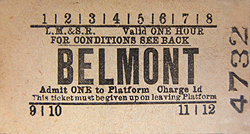 LMS platform tickets were issued until closure
LMS platform tickets were issued until closure
|
The track was lifted in early 1966 and the station buildings were demolished in July 1966.
Kenton Lane bridge had been developing cracks for many years and a concrete strengthening shell had been added underneath it maintaining the right of way under the bridge. In 1979 the bridge was completely rebuilt with the road deck being lowered by four feet with steps to the footpath that runs under the bridge. |
There were never any goods facilities at Belmont although the station was built on the site of the Bransgrove Kenton Lane Siding where waste material from the borough of St. Marylebone was unloaded.The rubbish was used by a local farmer John Bransgrove. A clause in his deeds prohibited the ploughing of top soil so he distributed the waste material on top of the soil and ploughed that! Shortly after Belmont Station opened a siding was added to the north of the station for unloading bricks during the development of the area for housing.
Although totem signs were fitted at Stanmore Village they weren't fitted at Belmont although they were made. Two Belmont totems were found in the station master's office at Harrow & Wealdstone in the 1960s.
BRIEF HISTORY OF THE HARROW & WEALDSTONE - STANMORE BRANCH
With a population of only 1,400 and three stations within easy reach there was little demand for a branch line to Stanmore. London hotel owner Fredrick Gordon acquired the Bentley Priory estate in 1882 with the intention of converting it into a country retreat and resort for his London hotel guests. To bring customers to his new 'resort', Gordon resurrected an earlier failed proposal to bring a railway to Stanmore by proposing his own Harrow and Stanmore Railway Bill; his line was authorised in 1886.
After failing to raise sufficient capital, Gordon proposed a second Bill in 1887 for a shorter 2 1/8 mile route from a junction with the London & North Western Railway at Harrow & Wealdstone to a terminus at Stanmore. By a further Act in 1891 the LNWR agreed to work the short branch with the Harrow & Stanmore Railway building and maintaining a single track line with a passenger and goods station at Stanmore and interchange sidings at Harrow. The act also allowed for an intermediate station if requested by the LNWR. After one year the LNWR agreed to take over maintenance and repair of the line.
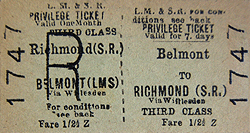 |
The H & SR was sold to the LNWR under 'The LNWR (Additional Powers) Act’ of 1st July 1899 before the line was completed with the first train running on 18.12.1890. The first timetable shows ten down and nine up trains Mondays to Fridays with one extra train on Saturdays. There were no Sunday trains as part of the initial deal secured by Fredrick Gordon. |
The H & SR was sold to the LNWR under 'The LNWR (Additional Powers) Act’ of 1st July 1899 before the line was completed with the first train running on 18th December 1890. The first timetable shows ten down and nine up trains Mondays to Fridays with one extra train on Saturdays. There were no Sunday trains as part of the initial deal secured by Fredrick Gordon.
In 1912 Harrow & Wealdstone Station was rebuilt as part of the LNWR widening and suburban electrification scheme. The branches from Watford to Croxley Green and Rickmansworth were both electrified but because of the position of the junction the Stanmore branch was not included which, in the long run, led to the demise of the line after the Metropolitan Railway (now the Jubilee line) opened their line to Stanmore on 10th December 1932 once urban development reached the area.
Gordon's hopes for the line failed to materialise and traffic was always light. Although there was some early development around the station the branch ran through open countryside until the 1920's. Gordon's Bentley Priory scheme was not a success and Bentley Priory eventually became a girls' school. Passenger traffic was further depleted after 1913 when the first motor busses arrived in the area. In 1923 the LNWR and with it the Stanmore branch were vested into the London Midland & Scottish Railway (LMS)
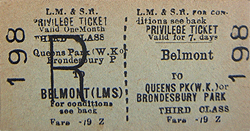 |
Passenger numbers improved in the 1930's when urban development finally reached the area between Harrow and Stanmore. To cater for this, the LMSR opened a wooden halt at Belmont on 12 September 1932, on the site of the former Kenton Lane siding, to serve a planned housing estate. Although the Metropolitan line from Wembley Park reached Stanmore shortly after |
Belmont opened fares were cheaper from Belmont and the new station attracted commuters. A Sunday service was introduced in 1934 and in order to cater for the added demand, Belmont was rebuilt in 1937. In 1938 the service had increased to 71 trains in each direction on weekdays with a ten minute interval during rush hours. Freight traffic also improved; with the ongoing urban development there was a demand for large quantities of bricks which were delivered to the yard at Stanmore and eventually a temporary siding was laid at Belmont to cater for some of this traffic.
The branch survived WW2 with only a short disruption to the service when a bomb left a crater near the track. In 1946 there was a fuel shortage and the Sunday service which had initially been very popular was temporarily suspended. When it was reinstated most passengers had found alternative means of transport and never returned to the railway so the Sunday service was permanently withdrawn from 27 July 1947. Although Belmont remained busy and was now the principal station on the line few passengers used the terminus at Stanmore and in 1952 the average daily usage was only 700 so it came as no surprise when BR announced closure of the branch which was making an annual loss of £4000. There was a robust campaign by residents of Belmont to keep their section of the line open; this was successful and from 15th September 1952 the passenger service was cut back to Belmont. Stanmore remained open being served by a daily freight train.
| Diesel Multiple Units began operating the Belmont service on 15th March 1954 when British Railways' experimental ACV diesel railcar was transferred from the St. Albans Abbey branch but it returned to St. Albans the following year and steam returned to Belmont. During the next seven years the line was worked intermittently by a variety of steam locomotives |
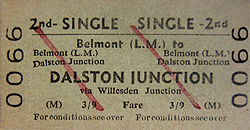 |
and DMU’s with the last steam service running on 15th December 1962. Off peak travel to Belmont became very light in the late 1950's while rush hour traffic remained heavy with some trains carrying up to 100 passengers in 1958; most of this was commuter traffic into London. Despite the lines continued popularity with commuters the branch was listed for closure in Dr Beeching's Reshaping of British Railways in 1963 as it was uneconomical to keep it open. No attempt was made to save costs on the line but there was a vigorous local campaign to keep the line open but to no avail with the line closing on 5th October 1964. To coincide with the closure of the passenger service to Belmont the freight service to Stanmore was withdrawn from 6th July 1964 and track lifting north of Belmont started in mid-September that year.
After closure a local campaign to reopen the line was started and this was considered by the Minister of Transport six months after closure and again in 1965 but the Minister decided "there is no economic or social justification for reopening the line".
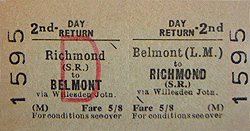 |
The first few chains out of Harrow were retained until 1968 as a headshunt for the Harrow goods yard and a test track for tamping machines. On 9th June 1965 the branch came back to life for one day when it was used by the BBC for an episode of 'The Londoners' TV series with a two car train shuttling up and down the branch all day. Only one other train went beyond the |
1/4 mile post when a weed killing train visited the branch on 25th June 1965.
Track lifting beyond the retained siding took place in January 1966 and the remaining siding was lifted at the end of 1968.
Despite a campaign in 1967 to renovate Stanmore Station as an arts centre and railway museum the station site was sold to a local property developer in 1969 while Harrow Council bought the remainder of the track bed much of it has now been developed although the central section of the branch is now a public footpath between Christchurch Road through Belmont to Wolverton Road.
Other web sites: Abandoned
Tube Stations & Dewi's Trains, Trams & Trolleys
Source: London's Local Railways by Alan A. Jackson - Published by David & Charles - 1978 & (2nd edition) 1999 - ISBN 0 7153 7479 6.
Harrow & Stanmore Railway by Peter G. Scott - Hartest Productions 1972 and (2nd edition) 1981 ISBN 0 9506469 1 1.
Tickets from Brian Halford Totem from David Brennand
Further reading: The Stanmore Village Branch - A photographic journey by I. Baker & J.E. Connor - 1998 Connor & Butler ISBN 978-0-947699-26-0
To see other stations on the Stanmore branch click on the station name:
Harrow & Wealdstone & Stanmore Village |

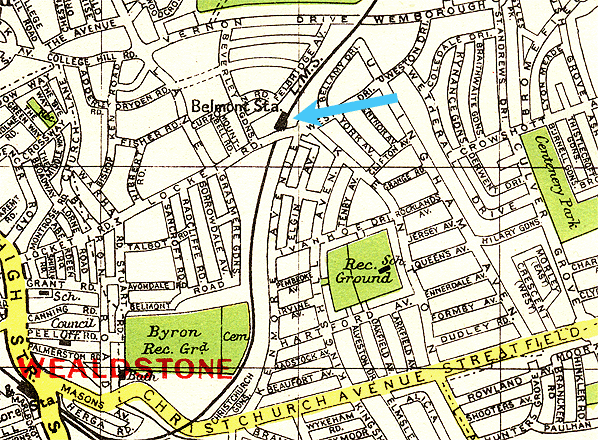


old1.jpg)

20.jpg)
25.jpg)
 Home Page
Home Page 






old5.jpg)
1.jpg)